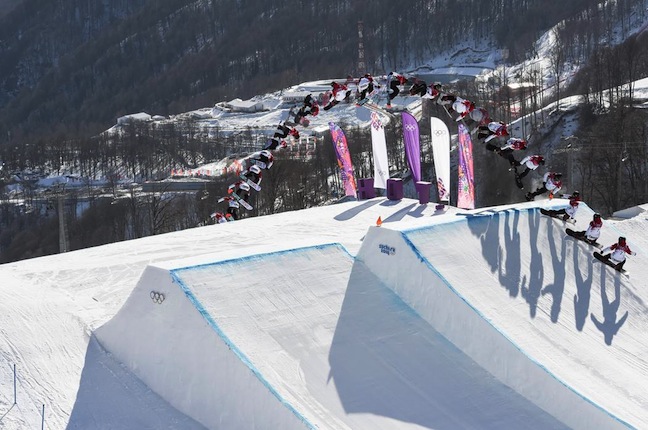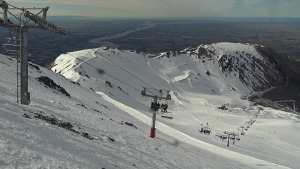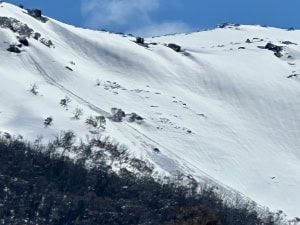OPINION – Death By Olympics?
![]()

Mark McMorris’ Cab Triple Underflip, Front Double Cork 1080, Backside Triple Cork 1440 wasn’t enough to secure the Gold medal in Sochi. Have we reached a crucial turning point in contest snowboarding? Image:: Via New York Times
Transfer | Throwback
EDITOR’s NOTE: Every four years, when the Olympics roll around, the same conversation seems to resurface: “What exactly did the Olympics give to Snowboarding? Are we happy with the legacy they’re imparting upon our sport?”. Snowboarding found its roots through the antithesis of the Olympics – a movement that said f–k you to the mainstream. Now that even more disciplines are being played out on the world stage, I thought it’d be the perfect time to revisit this well-researched, comprehensive opinion piece written by Transfer’s Founding Editor, Russell Holt back in 2010…
Transfer | Russ Holt
Famously, in 1998, Terje Haakonsen, the best snowboarder in the world at the time, told the IOC (International Olympic Committee) and the Olympics – in more appropriate terms – to f–k off! It was a David and Goliath moment, an insightful, powerful and momentous action by a kid from Norway who was only one of a few people who truly understood why snowboarding and the Olympics was not meant to be.
His actions signified the time when action sports were pulled into the Olympic world, kicking and screaming. Snowboarding became the first “Xtreme Sport” to be captured by the Olympic movement. In the wake of the ram-and-raid takeover of snowboarding, the IOC left a trail of destruction. Amongst the casualties: a collapsed ISF (International Snowboarding Federation), a divided snowboard community, an Olympic champion who wasn’t anywhere near the best in the world and a bunch of downhill skiers running the only Snowboard World Tour. Terje later said, “The IOC are supposed to do it for the love of all sports. If they love all sports, why do they have a ski federation to organise snowboarding events? That’s no love, that’s not even logic.”
But to understand more about the current state and then the future of halfpipe snowboarding in the Olympics, we first have to talk about why snowboarding is there in the first place. Why did the IOC want snowboarding?
Well unfortunately like a lot of things, it comes down to money. In the late 1960’s the IOC operated purely as a non-commercial organisation. But, during the lead up to the 1968 Winter Olympics in Grenoble, France commercialisation started to creep onto the agenda of its members. This change in ideals was such a horrific notion to the then president of the IOC, Avery Brundage, that he suggested the Winter Olympics be abolished, there and then. He felt it didn’t reflect the spirit of the Olympic movement.
By 1972, Brundage had left his post and the IOC gained a new freedom to roam the corporate landscape with the Olympics for sale. Thanks to sponsorships and broadcasting rights the IOC coffers quickly swelled to $45 million in just a few years. Now, you may be wondering what the relevance is here. Well, with money quickly changing hands over sponsorship, the IOC gained an invested interest to work closely with the sponsoring media to help boost their TV ratings, and help them gain a return on their huge investments. They had to fuel an insatiable need for a larger audience across different age groups – they had opened Pandora’s Box!.
By the early ’90s, the Olympics were in search of something to inject life into the games’ flailing ratings. It was the same time that Action Sports were peaking across the globe – skateboarding, motocross and snowboarding were pulling huge audiences and youth participation – it didn’t take long for the IOC to put one plus one together – the networks wanted it and the IOC had to make it happen. Action sports needed to be in the Olympics.
Snowboarding was the perfect target for the IOC, who turned to the FIS (Federation International Ski), their only link to action sports. They hoped the FIS could bring their knuckle-dragging friends from the mountains into the fold and capture that juicy youth market and boost those ratings once and for all.
It all sounds like a perfect corporate plan in theory, but in reality, the FIS had issues. First of all, they had always shunned snowboarding since its inception and had no existing partnerships or relationships to develop. But with time against them, the FIS in its infinite wisdom and arrogance, planned a smash-and-grab raid on snowboarding by dismissing any assistance from the ISF, the only global snowboard federation of the time and launched its own snowboard tour as the qualifying route for the Olympics.
Imagine that – a bunch of Downhill ski racers running a snowboard world tour! It was ridiculous and the sub-standard tour reflected it. None of the best riders attended and the FIS World Cups, and halfpipes were poorly built and poorly run. But the FIS persisted. Motivated by the launch of snowboarding into the 1998 Olympics on the horizon, they set about throwing their FIS corporate weight around in an effort to shutdown the ISF tour. Corporate tactics ensued and the FIS, backed by the IOC, threatened resorts around the globe with the loss of big FIS World Cup skiing events unless they signed ISF exclusion deals that would ban any ISF events from being held on their slopes. This brilliant corporate tactic stopped the naïve ISF dead in the water, starving it of not only resources, but of vital corporate sponsorships. The result was that by the time the 1998 Olympics rolled around, the ISF was all but dead and, snowboarding was born into the Olympics.
By 1998 (Nagano Games) the IOC was rife with corruption and an investigating committee called the level of corruption and bribery, “Astronomical”, even going so far as to implicate the then president of the IOC, Juan Antonio Samaranch, in bribery and corporate backhandedness.
In the same year, the US TV network CBS paid $375 million for the broadcasting rights for the Winter Olympics. By 2008, the IOC posted a record $2.4 billion in revenue for the year and a $383.3 million profit, a 68 percent increase since 2004. This was significantly helped by NBC paying a record $2 billion dollars for broadcasting rights of the 2012 Summer Games and the Vancouver 2010 Winter Games.
Now in 2010, and with the NBC $2 billion broadcast deal hanging – the IOC and NBC aligned the Vancouver Winter Olympic event calendar in such a way that three of America’s biggest Winter athletic stars would compete on the same day (17th Feb) in order to take on the “unbeatable rating show – American Idol”. The stars aligned for the NBC executives that day and Shaun White, Lindsay Vonn (skier) and Shani Davis (speedskater) all won gold for the USA and for the first time in US TV ratings history, 12 million more people tuned into something else than American Idol – the winner? NBC and the Winter Olympics Games at 30 million viewers. In Australia, it was a similar story in ratings; Channel Nine’s live broadcast of the Olympic Winter Games was a ratings hit with viewers. The three hour live broadcast from Vancouver dominated all opposition, winning every demographic, in every market across the country, securing a 47.2% share.
This is a good time to pose the question, so what does this mean for snowboarding? There are a few opinions, but unfortunately none lead to a very bright future. Most people within the snowboarding industry see it at face value, like Burton’s CEO, Laurent Potdevin: “Based on the tremendous increase in awareness that the Olympics bring to snowboarding, the Olympics will genuinely inspire more and more people to start riding and enjoy the sport.” He has a great point; with over three billion people watching the Winter Olympics world-wide, the exposure of snowboarding must inspire some new participation. With the goal in mind to sell more snowboards, Laurent explains that it’s very hard to quantify the impact the Olympics has: “It is hard to quantify the direct sales impact as a result of the Olympics’ timing. It is too late in the season to really affect sales. The biggest benefit is in the number of people around the world getting introduced to the sport.”
So with no stats after four Olympics to confirm the Olympics has a positive affect on snowboard sales, we have to look deeper – are people being affected in a positive way by seeing Shaun White do three Double Corks down an icy pipe?
“The Olympics provides a forum to show the rest of the world our sport… hopefully the Olympic viewing audience will come in to our sport as participants… we want to leave people with a good impression of the sport.” Laurent goes on to say. But what impression are they really getting? What impression do you get when you watch athletes flip at similar heights in Aerial Skiing? I love the mountains and the snow, but sorry, watching Aerial Skiing has never made me want to go skiing.
So for those three billion people seeing snowboarding on the TV at the Olympics, is it just like Aerial Skiing, where it is impossible for the average person to imagine themselves doing? Can it make people want to go snowboarding? It’s hard to say, but I’m not convinced that seeing Shaun White do 25-foot double flips down a rock-hard icey pipe would make me want to do it. In a similar way, seeing Danny Way launch skateboard jump-ramps over the Great Wall of China make you want to go skateboarding?
This brings us to the point that snowboarding is not in the Olympics to get people snowboarding, it’s not part of the IOC’s agenda. Their business is to make the Olympics entertaining for higher TV ratings. Steve Brown, an Australian Olympic halfpipe judge, explained this idea and the relevance of Shaun White: “We are very fortunate to have someone like Shaun White in the sport as he will force the industry to keep supporting pipe riders, otherwise, pipe might eventually end up the same as Alpine Racing and Boardercross and be almost totally ignored.”
“I think that we have a real problem for halfpipe. It’s evolving so fast that it will eventually become an elite-only sport much like aerial skiing as the level required is just way beyond the average rider and it will be the Olympics that will keep it alive.” Steve explains. This is an interesting argument, because while the success of halfpipe competition grows, its popularity with everyday snowboarders has been going in the opposite direction. Halfpipe snowboarding now risks losing is its relevancy to regular snowboarders.
Has halfpipe outgrown the reach of the average snowboarder? Can regular snowboarders or new ones, relate to halfpipe? “I definitely believe that the level of pipe riding is creating a barrier of entry. I have been very worried about this for a long time now and think that these new tricks (Double Corks) have just significantly raised that barrier”, Steve concluded.
With less people participating at their local hill in the halfpipe and halfpipe sizes increasing, halfpipes are also becoming too expensive. Sam Lee, the General Manager of Snow Park NZ, has just upgraded their halfpipe to Olympic size: “The biggest trend has been a decline in participation for the general population, as pipes have gotten bigger the costs to build the pipes have risen and we are seeing less and less resorts building pipes”. But luckily for Snow Park it is known around the globe as the epicentre for elite halfpipe training during the Southern hemisphere winter. This keeps their pipes very busy, but as Sam recognises, it also deters the public; ” We have noticed the level of riding is somewhat intimidating during the peak season and it is hard to get everyday riders into the pipe without some encouragement. I definitely go out on the hill on my snowboard and into the pipe to ensure that 99% of the other people in the pipe look good.”
So with the future of halfpipe snowboarding now at risk of turning into the snowboard version of Aerial Skiing – for elite only – owned, packaged and delivered by the IOC and the FIS. What does this leave for the millions of snowboarders around the world who aim to keep competing without trainers, urine tests and gym routines?
For Terje Haakonsen, the answer lies in looking at snowboarding from the outside and comparing that with other sports like boxing: “Snowboarding is extremely confusing for the media.” Terje explains. “Like when FIS holds their ‘World Championships’ in Korea, while in reality, the world’s best riders are all at the Burton European Open. The mainstream needs clarity. They’re like, ‘Should we write about the ‘Worlds,’ or should we write about the best riders?’ Fuck, we are not even going to write about it because it’s such a circus.” Where’s the credibility?
It’s at this point that the TTR World Snowboard Tour starts making a whole lot of sense for the future of snowboarding and competition. The TTR, that thankfully filled the void left by the ISF, provides an open format tour accepting all snowboarders and encompassing all aspects of snowboarding: halfpipe, slopestyle, rails, big air and even freeriding – like Travis Rice’s Natural Selection Freeride event, which was a sanctioned TTR World Tour event with the same rankings as some halfpipe or rail event. Basically, any event in any format can be a part of the TTR Tour and because of that the TTR Tour can naturally evolve with the changes of snowboarding. The key to its success is flexibility, not rigidity like the FIS and Olympics, and in the end the overall winner of this tour are the snowboarders.
When the Olympic movement casts its next Winter Games challenge in 2014; “Aim Swifter, Higher and Stronger”, will it be referring to the athletes or to its own bank accounts?




